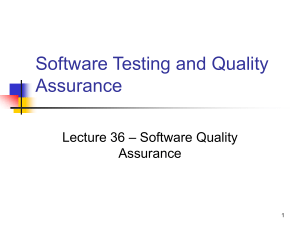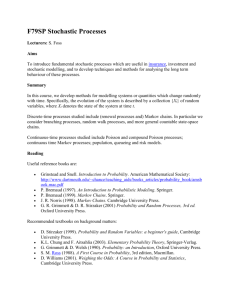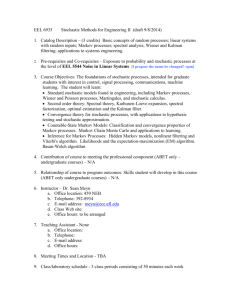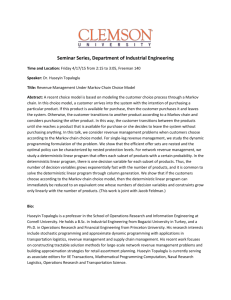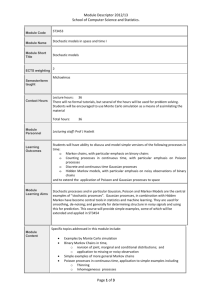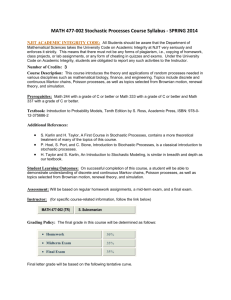Preface - University of Warwick
advertisement
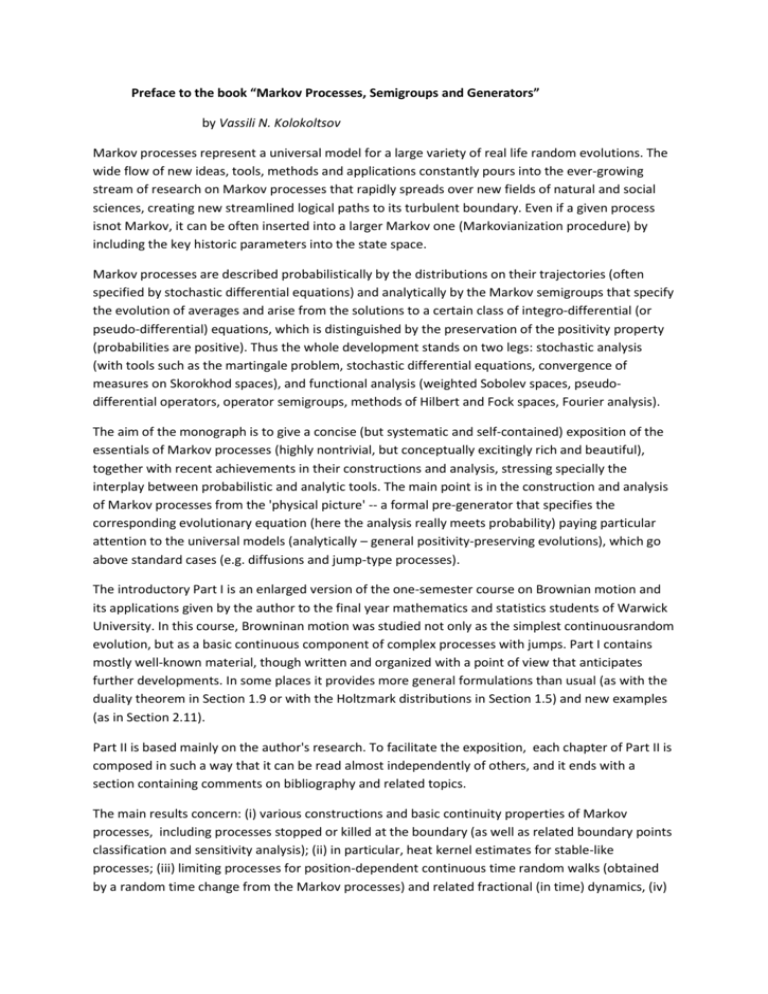
Preface to the book “Markov Processes, Semigroups and Generators” by Vassili N. Kolokoltsov Markov processes represent a universal model for a large variety of real life random evolutions. The wide flow of new ideas, tools, methods and applications constantly pours into the ever-growing stream of research on Markov processes that rapidly spreads over new fields of natural and social sciences, creating new streamlined logical paths to its turbulent boundary. Even if a given process isnot Markov, it can be often inserted into a larger Markov one (Markovianization procedure) by including the key historic parameters into the state space. Markov processes are described probabilistically by the distributions on their trajectories (often specified by stochastic differential equations) and analytically by the Markov semigroups that specify the evolution of averages and arise from the solutions to a certain class of integro-differential (or pseudo-differential) equations, which is distinguished by the preservation of the positivity property (probabilities are positive). Thus the whole development stands on two legs: stochastic analysis (with tools such as the martingale problem, stochastic differential equations, convergence of measures on Skorokhod spaces), and functional analysis (weighted Sobolev spaces, pseudodifferential operators, operator semigroups, methods of Hilbert and Fock spaces, Fourier analysis). The aim of the monograph is to give a concise (but systematic and self-contained) exposition of the essentials of Markov processes (highly nontrivial, but conceptually excitingly rich and beautiful), together with recent achievements in their constructions and analysis, stressing specially the interplay between probabilistic and analytic tools. The main point is in the construction and analysis of Markov processes from the 'physical picture' -- a formal pre-generator that specifies the corresponding evolutionary equation (here the analysis really meets probability) paying particular attention to the universal models (analytically – general positivity-preserving evolutions), which go above standard cases (e.g. diffusions and jump-type processes). The introductory Part I is an enlarged version of the one-semester course on Brownian motion and its applications given by the author to the final year mathematics and statistics students of Warwick University. In this course, Browninan motion was studied not only as the simplest continuousrandom evolution, but as a basic continuous component of complex processes with jumps. Part I contains mostly well-known material, though written and organized with a point of view that anticipates further developments. In some places it provides more general formulations than usual (as with the duality theorem in Section 1.9 or with the Holtzmark distributions in Section 1.5) and new examples (as in Section 2.11). Part II is based mainly on the author's research. To facilitate the exposition, each chapter of Part II is composed in such a way that it can be read almost independently of others, and it ends with a section containing comments on bibliography and related topics. The main results concern: (i) various constructions and basic continuity properties of Markov processes, including processes stopped or killed at the boundary (as well as related boundary points classification and sensitivity analysis); (ii) in particular, heat kernel estimates for stable-like processes; (iii) limiting processes for position-dependent continuous time random walks (obtained by a random time change from the Markov processes) and related fractional (in time) dynamics, (iv) the rigorous Feynman path-integral representation for the solutions of the basic equations of quantum mechanics, via jump-type Markov processes. We also touch upon the theory of stochastic monotonicity, stochastic scattering, stochastic quasi-classical (also called small diffusion) asymptotics, and stochastic control. An important development of the methods discussed here is given by the theory of nonlinear Markov processes (including processes on manifolds) presented in the author's monograph “Nonlinear Markov processes”, Cambridge University Press, 2010. They are briefly introduced at the end of Chapter 5. It is worth pointing out the directions of research closely related to the main topic of this book, but not touched here. These are Dirichlet forms, which can be used for constructing Markov processes instead of generators, Mallivin calculus, which is a powerful tool for proving various regularity properties for transition probabilities, log-Sobolev inequalities, designed to systematically analyze the behavior of the processes for large times, and processes on manifolds. There exists an extensive literature on each of these subjects. The book is meant to become a textbook and a monograph simultaneously, taking more features of the latter as the exposition advances. I include some exercises, their weight being much moresound at the beginning. The exercises are supplied with detailed hints and are meant to be doable with the tools discussed in the book. The exposition is reasonably self-contained, with pre-requisites being just the standard math culture (basic analysis and linear algebra, metric spaces, Hilbert and Banach spaces, Lebesgue integration, elementary probability). We shall start slowly from the prerequisites in probability and stochastic processes, omitting proofs if they are well presented in university text books and not very instructive for our purposes, but stressing ideas and technique that are specially relevant. Streamlined logical paths are followed to the main ideas and tools for the most important models, by-passing wherever possible heavy technicalities (say, by working with L\'evy processes instead of general semi-martingales, or with left-continuous processes instead of predictable ones). A methodological aspect of the presentation consists in often showing various perspectives for key topics and giving several proofs of main results. For example, we begin the analysis of random processes with several constructions of the Brownian motion: 1) via binary subdivisions anticipating the later given It\^o approach to constructing Markov evolutions, 2) via tightness of random-walk approximations, anticipating the later given LLN for non-homogeneous random walks, 3) via Hilbertspace methods leading to Wiener chaos that is crucial for various developments, for instance for Malliavin calculus and Feynman path integration, 4) via the Kolmogorov continuity theorem. Similarly, we give two constructions of the Poisson process, several constructions of basicstochastic integrals, several approaches to proving functional CLTs (via tightness of random walks, Skorohod embedding and the analysis of generators). Further on various probabilistic and analytic constructions of the main classes of Markov semigroups are given. Every effort was made to introduce all basic notions in the most clear and transparent way, supplying intuition, developing examples and stressing details and pitfalls that are crucial to grasp its full meaning in the general context of stochastic analysis. Whenever possible, we opt for results with the simplest meaningful formulation and quick direct proof. As teaching and learning material, the book can be used on various levels and with different objectives. For example, short courses on an introduction to Brownian motion, L\'evy and Markov processes, or on probabilistic methods for PDE, can be based on Chapters 2, 3 and 4 respectively, with chosen topics from other parts. Let us stress only that the celebrated It\^o's lemma is not included in the monograph (it actually became a common place in the textbooks). More advanced courses with various flavors can be built on part II, devoted, say, to continuous-time random walks, to probabilistic methods for boundary value problems or for the Feynman path integral. Finally, let me express my gratitude to Professor Niels Jacob from the University of Wales, Swansea, an Editor of the De Gryuter Studies in Mathematics Series, who encouraged me to write this book. I am also most grateful to Professor Nick Bingham from Imperial College, London, for reading the manuscript carefully and making lots of comments that helped me to improve the overall quality immensely.




